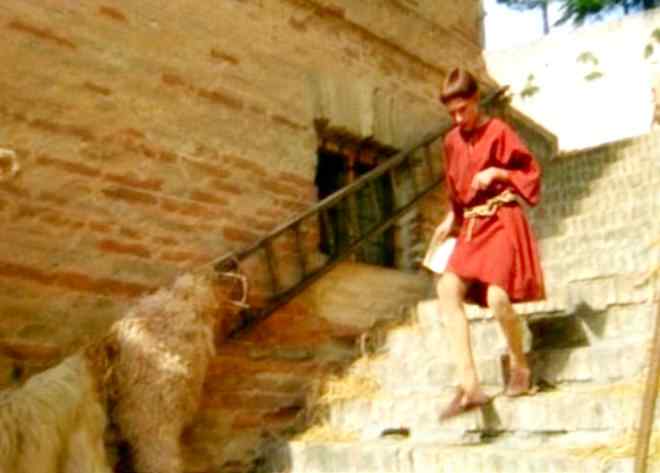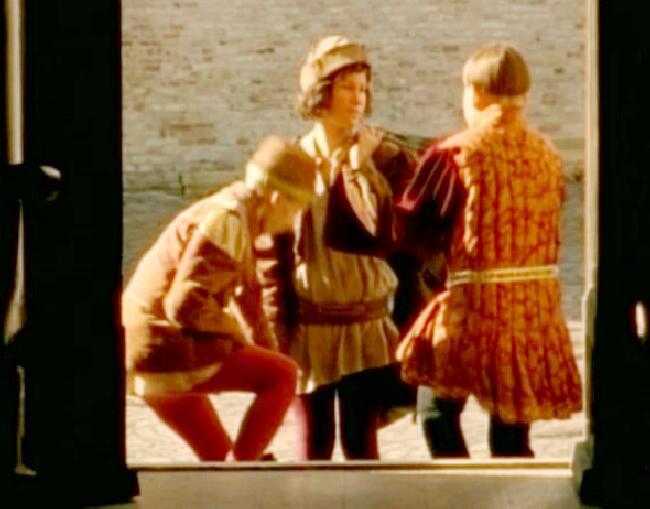
Boys Costumes Depicted in Documentsary Television Shows:
The Medici: Godfathers of the Renaissance (United States, 2004)

Figure 1.--The documentary begins with this messenger boy (about 12 years old) delivering a letter to a member of the Medici family in 1400. The boy wears a red tunic with long wide sleeves; it is belted at the waist. He also wears tan hose (equivalent to modern tights) and brown leather shoes. Notice the late medieval haircut.
|
Justin Hardy's TV documentary film, "The Medici: Godfathers of the Renaissance" (2004) is an excellent historical overview. The film dramatizes the rich and often
violent history of the famous Florentine family that dominated one corner of Italy culturally, politically, and religously for almost two centuries. The film was produced
in the UK and shown on television in the United States as a PBS series. It begins in 1400 when the family were rising to power and influence as merchant princes
and bankers and takes the story forward to the end of the reign of Cosimo I, Duke of Florence, in the 16th century. The most impressive of the Medici rulers was
probably Lorenzo de Medici (patron of Michelangelo, Bottecelli, Ficino, and other great artists and humanist intellectuals). The family produced no fewer than three
popes (including the famous Leo X). Of course the roles of historical figures are reconstructed and interpreted by modern actors.
TV-ology
Justin Hardy's TV documentary film, "The Medici: Godfathers of the Renaissance" (2004) is an excellent historical overview. The film was produced
in the UK and shown on television in the United States as a PBS series.
Subject
The film dramatizes the rich and often
violent history of the famous Florentine family that dominated one corner of Italy culturally, politically, and religously for almost two centuries. It begins in 1400 when the family were rising to power and influence as merchant princes
and bankers and takes the story forward to the end of the reign of Cosimo I, Duke of Florence, in the 16th century. The most impressive of the Medici rulers was
probably Lorenzo de Medici (patron of Michelangelo, Bottecelli, Ficino, and other great artists and humanist intellectuals). The family produced no fewer than three
popes (including the famous Leo X).
Actors
The roles of historical figures are reconstructed and interpreted by modern actors. There is a lot of art work which could have been used, bur primarily Hardy choose to dramtize the history with actors.
Costuming
One image shows a Florentine messenger boy (about 12 years old)
delivering a letter to a member of the Medici family in 1400. The boy wears a
red tunic with long wide sleeves; it is belted at the waist. He also wears
tan hose (equivalent to modern tights) and brown leather shoes. Notice the
late medieval haircut. Considerable attention is given to Michelangelo Buonarroti (1475-1564), the sculptor of the famous David and the painter of the Sistine ceiling in Rome, as a teenage boy. As a young lad he was taken in by Lorenzo de Medici (known as Lorenzo the Magnificent--1449-92) and raised on terms of equality with Lorenzo's own sons. In Lorenzo's palace he was exposed to many of the greatest minds and talents of the Italian Renaissance (including the painter Bottecelli and the humanist philosopher Ficino). Two of the Medici boys are shown here with their young genius friend. All three of the boys are dressed in typical 15th-century male dress--belted tunics over hose (or tights). Michelangelo is the
central figure with a felt cap and a hair style that covers his ears. All
three boys here are presented as young teenagers. An image shows Michelangelo alone--at about age 13. Note that he wears
a short open jacket over his belted tunic or doublet. The jacket is designed
to emphasize the breadth of his shoulders. He wears crimson hose.

Figure 2.--Michelangelo as a young lad was taken in by Lorenzo de Medici (known as Lorenzo the Magnificent--1449-92) and raised on terms of equality with Lorenzo's own sons. In Lorenzo's palace he was exposed to many of the greatest minds and talents of the Italian Renaissance (including the painter Bottecelli and the humanist philosopher Ficino). Two of the Medici boys are shown here with their young genius friend. All three of the boys are dressed in typical 15th-century male dress--belted tunics over hose (or tights). Michelangelo is the
central figure with a felt cap and a hair style that covers his ears.
|
Art and Repression
The program discusses Donatello (1286-1466), one of the great sculptors of Florence, and his sculpture of David. The sculpture depicts David as naked except for
his garlanded felt hat and knee length boots because he represents David of
the David and Goliath story. For Donatello's famous sculture of David, see
the following (third) photograph. The sensuality of Donatello's statue caused
considerable negative criticism at the time and was considered revolutionary.
But the Medici family promoted artistic tolerance and creative innovation in
Florence until the backlash of Savanrola, the puritanically conservative monk
who preached against fleshly art and glorification of the human body,
initiated a counter-revolution against the culture patronized so lavishly by
the Medici. The famous "bonfire of the vanities" is depicted in which the
wealthy citizens of Florence were encouraged to commit many of their books,
paintings, jewelry and other treasures to the flames.
Cosimo
Cosimo de Medici (Cosimo I, Grand Duke of Tuscany--1519-
74) was a cental gfigure in the Meddici deama. He was a distant cousin of his predecessor, who had been murdered, so
that he succeeded to the dukedom as a boy of only 17. His extreme youth (17)
is stressed in the film although the actor who plays the part is obviously
somewhat older. Here we see the "boy" Cosimo in his ducal splendor with ruff,
chain of office, and ermine trimmed suit immediately after his election as
Grand Duke.
HBC Links
There are several HBC pages dealing with the Renaissance and related issues.
Michelangelo Buonarroti was one of the greatest artists of all time. He had an enormous influence on the art of the Renaissance. Incredibly he felt it was not painting that was his calling, but sculpture. As a result the number of his paintings are limited, but there are numerous drawings, each a masterpiece in their own right. We note one that is a dazzling image of a Florentine boy.
The popolo grasso part in Florence gained political power near the end of the 14th century. The city for 40 years was ruled by a small group of middle=class merchants. Gradually opposition grew. Merchants who had been excluded from power incited popular opposition. Giovanni de' Medici who was head of the richest and company of Calimala emerged as the leader of the popular forces.
Giovanni died (1429). Political tensions grew and poular loyalties increasingly focused on the Medici. Giovanni's oldest son emerged as a virtual feudal lord of Florence, but retained a republican facade. He died (1464) and was replaced by the weak Piero the Gouty (1464-1469). Next came Piero's son, Lorenzo the Magnificent. Lorenzo continued the Medici practice of maintaing the republican facade of the Commune, but in effect turned the city into a feudal duchy. Except in name, Lorenzo was every bit a feudal lord. He is best known as a lover and patron of the arts and philosophy. He was a strong force in promoting humanism. Lorenzo was wounded during the Pazzi conspiracy (1478). Popular opinion swing against thev Medici. An aestetic, purtanical Dominican priest named Savanarola who was critical of humanism and the art of the Renaissance seized control of Florence briefly before being burned as a heritic. The Florentine Republic formally came to an end with Alessandro (1530). The armies of the Pope Clemente VII and the Emperor Charles V beseiged the city with a Spanish army (1529) and installed Allesandro first Duke of Florence. Cosimo expanded the borders and became Grand Duke of Tuscany. After Cosimo the influence of Florence gradually declined.
Although generally classified by most scholars as the last century of the medieval era, the 14th century is generally seen as the beginning of the Renaissance and the beginning of a modern state of mind. "Renaissance" means "rebirth" in French and describes the cultural and economic changes that occurred in Europe beginning in the 14th century. The precise time is difficlt to set and of course varied accross Europe. The Renaissance began at Firenze around 1300 and gradually spread north. Even so, the indicators that constitute the Renaissance did not reach other areas of Europe 1-2 centuries. It was during the Renaissance that Europe emerged from the Feudal System of the Middle Ages. The stagnant Medieval economy began to expand. The Renaissance was not just a period of economic growth. It was an age of intense cultural ferment. Enormous changes began in artistic, social, scientific, and political endevours. Perhaps of greatest importance was that Europeans began to develop a radically different self image as they moved from a God-centered to a more humanistic outlook.
The Papacy played a key role in both the Renaissance and the history of the Medicci family. Two of the family were elected popes and were among the Renaissance popes.
HBC

Navigate the Boys' Historical Clothing Web Site:
[Return to the Main English TV page]
[Return to the Main "M" alphabetical TV page]
[Introduction]
[Activities]
[Biographies]
[Chronology]
[Clothing styles]
[Countries]
[Topics]
[Bibliographies]
[Contributions]
[FAQs]
[Glossaries]
[Satellite sites]
[Tools]
[Boys' Clothing Home]
Created: May 16, 2004
Last updated: May 16, 2004




